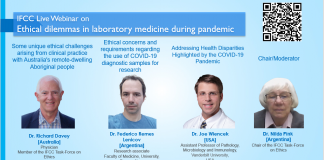Metrological traceability is a 10-syllable term that is difficult to say, but important to understand. It is essential to the validity of clinical results, so it must always be considered. If clinical test results are to be comparable across time, across different instrument platforms, or across labs, they must be metrologically traceable to the same measurement reference.
Establishing metrological traceability requires that the calibration material used for a result (or a run, or series of calibration materials), has certified property values that have an unbroken chain of comparisons going back to the appropriate national or international standard—for example, the use of certfied reference materials (CRM) from a National Metrology Institute (NMI) such as the National Institute of Standards and Technology (NIST) which have assigned values that are traceable to the International System of units (SI units). Other respected appropriate standards that are used to establish metrological traceability and are common to the clinical lab industry include those produced by the World Health Organization (WHO) with arbitrary units, often called “International Units” (IU).
Metrological traceability is the subject of several ongoing efforts at the Joint Committee for Traceability in Laboratory Medicine (JCTLM), the International Federation for Clinical Chemistry and Laboratory Medicine (IFCC), and the American Association for Clinical Chemistry (AACC) Harmonization Task Force and the International Consortium for Harmonization. It has been addressed by the International Organization for Standardization (ISO), by the Clinical and Laboratory Standards Institute (CLSI), and by the International Cooperation for Traceability in Analytical Chemistry (CITAC).
The JCTLM is a project of the International Bureau of Pounds and Measures (BIPM), and is composed of representatives from BIPM, IFCC, and the International Laboratory Accreditation Cooperation (ILAC). ILAC is a cooperation of 95 laboratory accreditation bodies from 80 countries that accredit testing and calibration laboratories to the requirements of ISO/IEC 17025 and ISO 15189.
The formal definition
As defined by the International Vocabulary of Metrology (VIM), metrological traceability is a “property of the measurement result whereby the result can be related to a reference through a documented unbroken chain of calibrations, each contributing to the measurement uncertainty.” Notes in the definition clarify that a “reference” can be a definition of a measurement unit, a measurement procedure, or a measurement standard, and (for internationally recognized accreditation) the reference should be a national or international reference standard with traceability to the International System of Units (SI), where available.
It is important to recognize that metrological traceability is different from other forms of “traceability” within a laboratory. It is different from the traceability of a sample as it moves through the measurement system (sometimes called “chain of custody”), and it is different from the “traceability of calculations,” which involve tracking original instrument indications and any manual calculations or transfer of results. Metrological traceability relates to the measurement result itself, the data that is produced in the laboratory that is provided to the “customer,” and is used to make critical decisions that could have direct impact on the health of a patient. Metrological traceability is about the units of measurement, how the measurement results compare to other measurement results, and what the measurement results mean. Metrological traceability helps ensure that we are comparing apples to apples and, furthermore, that we are comparing a Gala apple to a Gala apple—and with what level of certainty we can say that our Gala apple is indeed a Gala apple. Metrological traceability should not be confused with tracking the sample or the result as they move through the laboratory; rather, it relates a measurement result back to a reference that allows (or not) comparison to other results for the same analyte.
Achieving metrological traceability
Here are three common examples of how metrological traceability can be achieved:
- Calibration to the SI (or other reference) through a primary reference material from an NMI (for example, in the United States, to certified property values contained in SRMs from NIST). This can be conducted by a single laboratory (for example, glucose in serum).
- Use of a reference measurement method by a network of expert laboratories using a well-described reference measurement method. This requires that all laboratories are independently verified to be competent (for example, creatinine in serum).
- Use of a reference method by a single expert laboratory (for example, total cholesterol in serum).
Establishing metrological traceability can be expensive, but past efforts have demonstrated benefits to anyone who has tracked interlaboratory agreement of measurements in recent years; that is, whether improvements in method agreement for creatinine, cholesterol, or glucose seem like recent improvements to you (or, in the experience of the principal author, what has occurred with the use of beta hCG measurements in the past 35 years). Harmonization of results obtained by different measurement methods is possible for every analyte.
If you follow rules that require strict adherence to the manufacturers’ guidelines, then there is little you can do to affect the traceability of results that you report. We recommend contacting the manufacturers and requesting information detailing how they ensure metrological traceability of results using their equipment. If you have inter-method agreement factors to harmonize results from different instruments in your laboratory, there is also little else that you can do to improve traceability.
Remember that metrological traceability requires measurement results to be traceable to SI units or another appropriate reference when that isn’t possible. In a clinical laboratory, metrological traceability is often achieved through the use of certified reference materials or the use of reference methods. The JCTLM maintains a searchable database of certified reference materials, accepted reference methods, and standardization organizations, available at this address: http://www.bipm.org/jctlm/.
Source: MLO











